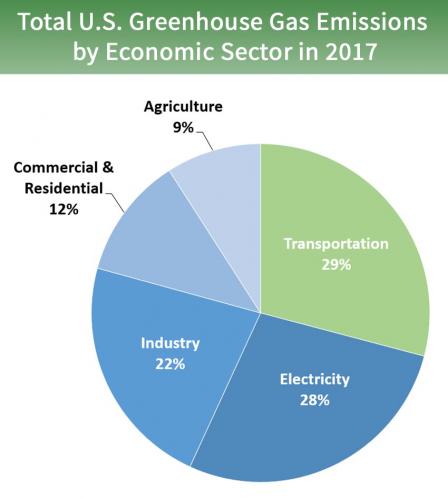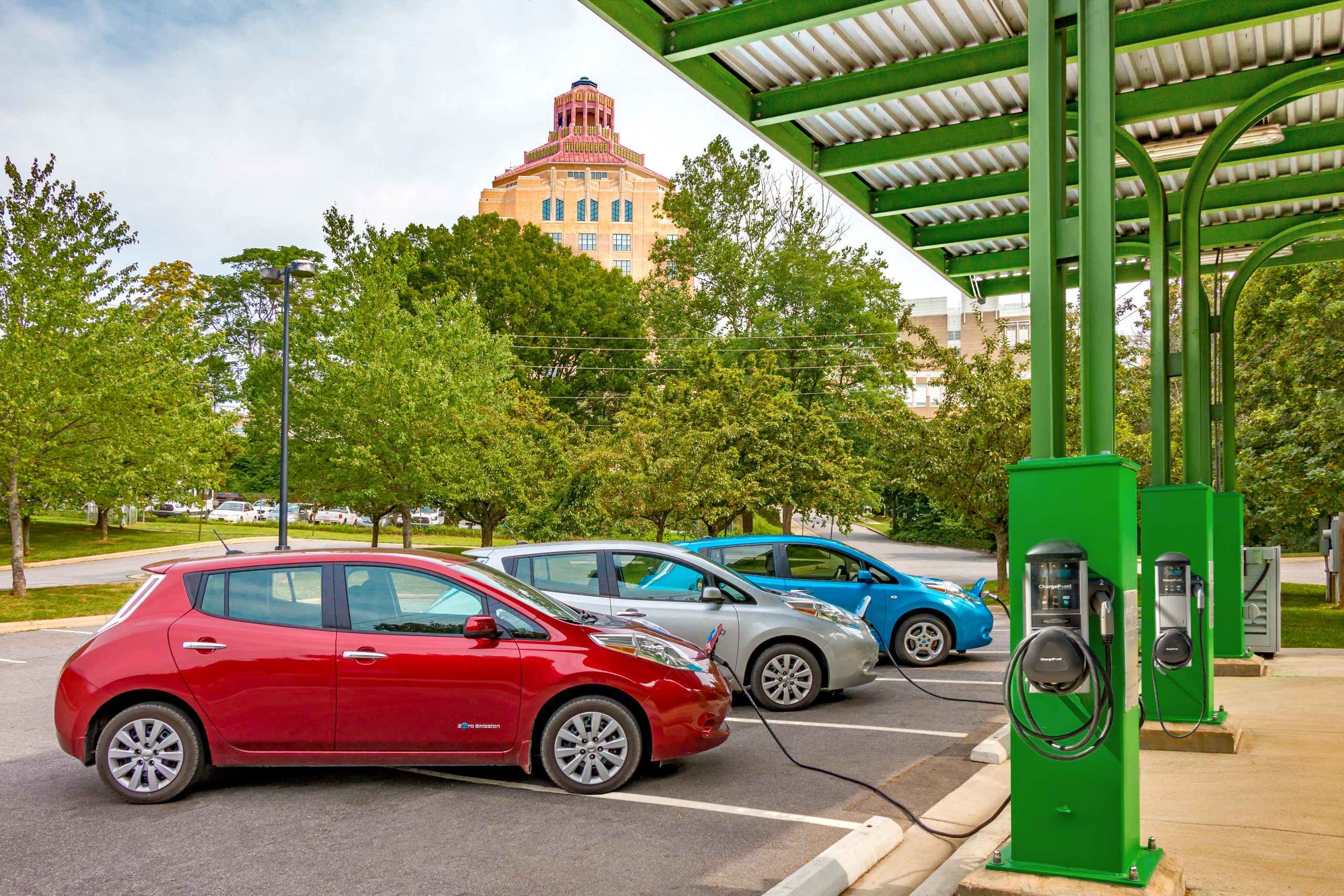 We learned this year that the transportation sector is now the most significant contributor to U.S. greenhouse gas (GHG) emissions, the pollutants at the root of the climate crisis. We also learned that the human, economic, and environmental impacts of climate change are direr than previously assumed, requiring bold and urgent action to minimize air and sea temperature rise.
We learned this year that the transportation sector is now the most significant contributor to U.S. greenhouse gas (GHG) emissions, the pollutants at the root of the climate crisis. We also learned that the human, economic, and environmental impacts of climate change are direr than previously assumed, requiring bold and urgent action to minimize air and sea temperature rise.
What is bold and urgent action in the transportation sector? Firstly, look beyond electrifying cars, trucks, and buses alone. To make impactful transportation emissions reductions, we also need to ensure EVs are powered with clean energy, that we implement effective mass transit systems and walkable and bikeable communities, and that everyone everywhere has access to the benefits electric transportation offers.
The Challenge
Making the shift to electric transportation is a challenge at every scale. Whether you are a consumer in the market for a car or a fleet manager replacing transit buses, you are engaging in a risk vs. reward calculation. Below are some of the perceived risks and potential rewards often weighed by consumers and fleet managers considering EV purchases:
PERCEIVED RISKS
- EVs are often more expensive
- EVs have a limited range
- Public charging stations are lacking
- EV batteries may lose capacity over time and reduce range
- EV electricity demand may lead to powerplants burning more coal and natural gas
POTENTIAL REWARDS
- EV performance is far superior
- Charging at home is easy and convenient
- Save money and time: no gas stations, no oil changes, very little maintenance.
- Reduce transportation greenhouse gas emissions upwards of 60% on today’s utility resource mix
- Breathe easier—no tailpipe pollution
- Enhance energy security by reducing dependence on oil
Accessing available information to evaluate these risks and rewards can be difficult. Electric transportation is a nascent industry without a lot of history and best practices. The fact is if you are riding in an electric car, truck, or bus today you are part of the early adopter wave. In this exciting early market moment, there exist opportunities to not only change what kind of vehicle we drive but to fundamentally transform the transportation sector through holistic and innovative policy and planning.
The Opportunities
Electric transportation policy, whether at the local, state, or national levels, should be aimed at reducing risks and maximizing the rewards. Here in the Southern U.S., we have opportunities to do just that. But to succeed, we must look beyond the vehicle itself and consider electric transportation in a holistic context.
A) Clean the Grid
When it comes to GHG emission, The economics of renewable energy has never looked so good. Under certain circumstances, solar, wind, and geothermal are cost-competitive with coal, gas, and nuclear generation. Cities across the nation are committing to 100% renewable energy. Here in the South, executive orders by Governors’ in VA and NC have propelled clean energy and transportation planning. At the same time, FL’s Commissioner of Agriculture unveiled a state-wide climate plan at the recent Florida Energy & Climate Summit.
 These local and state commitments and policies are pushing electric utilities to clean the grid, which is critical to maximizing the rewards of transportation electrification. How clean an EV runs directly relates to how clean the grid is. Union of Concerned Scientists data shows that in areas of the country with the cleanest electricity, emissions from driving an EV are equivalent to driving a 191 MPG car, and where the grid is dirtiest, a 38 MPG car. Hence, for EVs to deliver maximum climate, energy security, and public health benefits, the grid needs more clean energy. It is worth noting that the electric utility sector is the second-largest emitter of GHG emissions in the U.S., which makes it imperative to ramp up clean energy development alongside EV adoption.
These local and state commitments and policies are pushing electric utilities to clean the grid, which is critical to maximizing the rewards of transportation electrification. How clean an EV runs directly relates to how clean the grid is. Union of Concerned Scientists data shows that in areas of the country with the cleanest electricity, emissions from driving an EV are equivalent to driving a 191 MPG car, and where the grid is dirtiest, a 38 MPG car. Hence, for EVs to deliver maximum climate, energy security, and public health benefits, the grid needs more clean energy. It is worth noting that the electric utility sector is the second-largest emitter of GHG emissions in the U.S., which makes it imperative to ramp up clean energy development alongside EV adoption.
B) Electrify Transportation, Quickly
Over the past few years, the EV market has seen prices fall, and model availability rise. Passenger cars are where most of the attention has been, but delivery trucks, and transit and school buses are on the market and expanding every day, and the long-awaited pick-up truck is on the way. As EV offerings diversify, the use cases for electrification grow.
According to a recent analysis by the Rocky Mountain Institute, to remain below the feared 2°C temperature rise threshold, we need 1 in 5 cars on the global roads to be EVs by 2030. In the U.S., that equals 40-50 million EVs.

There are currently 44 models of electric vehicles, both full-battery and plug-in hybrid, ranging in price from $24,000 to $140,000; Europe has over 200 models. There are 70 models of electric trucks and buses from 27 different manufacturers. These heavy-duty electric vehicles offer 44 to 79 percent lower GHGs than diesel. The U.S. has a fleet of 300 electric buses; China has 421,000.
The good news is that consumers and fleet managers have a growing selection of EVs to choose from to meet a variety of transportation needs. The even better news is that in other countries where climate and emission reduction policy actions are accelerating the EV market, there is greater vehicle availability and adoption. That indicates that strong climate and emissions policies at the federal level here in the U.S. would likely increase availability and adoption as well.
In the absence of federal leadership, states have stepped in. The best current example of state policy is the Zero Emission Vehicle (ZEV) Program that sets transportation emissions requirements per California’s stringent guidelines, including setting EV sales quotas for automobile manufacturers. The ZEV MOU states include Colorado, Connecticut, Maine, Maryland, Massachusetts, New Jersey, New York, Oregon, Rhode Island, and Vermont.
Here in the South, many of the same states and cities that have committed to clean energy are developing plans, policies, and implementation strategies to increase EV adoption, both in state and city fleets and the broader consumer market. Initiatives like Protect our Coast—Drive Electric, Plug-In NC, and Drive Electric Florida are working to provide consumer, municipal, and state-level education and outreach to support policy and implementation work. But more work needs to be done regionally to craft and implement the local and state polices that will
C) Reduce Vehicle Miles Traveled
The fastest and most effective way to curb GHG emissions from transportation is to reduce the vehicle miles traveled. This is easier said than done. In cities with robust public transit systems and established pedestrian and bike alternatives, getting residents to opt-out of personal vehicles is more viable than in cities and rural communities that lack such resources. But that is no reason to not work on the issue! In response to congestion and parking shortages, many cities are expanding or retrofitting mass transit systems, most notably buses and light rail. Greenways and bike paths are becoming more commonplace in both cities and towns. Additionally, the emergence of ride-sharing and the encouragement of carpooling through access to high occupancy vehicle (HOV) lanes and other incentives, offer alternatives to single-occupancy cars.
Reducing VMT is also a public health goal. According to the U.S. Department of Transportation, Decreasing annual VMT per capita can directly improve air quality and the overall health of a population. And because significant transportation corridors often run through and disproportionally impact economically disadvantaged communities, VMT is an environmental justice concern as well
In the South, where many cities have been growing a sprawling, reducing VMT is a challenge. Advocate organizations are pressuring state departments of transportation to include significant VMT reductions in long-term roadway planning. Organizations like The Congress for New Urbanism are reimagining city and town design to create less car-dependent communities. Pairing long-term community planning work with transportation electrification is critical to maximizing GHG reductions and improving community health and well-being.
D) Ensure Equity and Access for All
This final holistic consideration is critical. The shift to electric transportation has many benefits, including lower cost of ownership, reduced exposure to pollution, and superior performance. These benefits must be accessible and available to all. The issue of electric transportation equity has emerged as a cornerstone goal of seemingly every electric transportation plan at state and local levels. In California, the Greenlining Institute has developed an electric transportation equity tool kit and has gotten traction in recent utility and municipal policy reform efforts. But figuring out how to implement equity and access goals at scale remains a work in progress.
In the South, groups like the NC Justice Center and EV Hybrid Noire are working to develop effective EV outreach to traditionally underserved and economically disadvantaged communities. They and others like the NC Sustainable Energy Association are beginning to collaborate with financial institutions to provide financing for affordable used EVs. Meanwhile, cities, environmental and social justice organizations are pushing utilities and state governments to prioritize EV charging infrastructure installations in underserved communities, and for investments in electric transit and school buses that deliver human health and environmental benefits to all.
Transportation equity is ripe for innovation and investment. If done right, electric transportation investments in traditionally underserved communities will deliver environmental, social, and financial rewards where the rewards are needed most.



